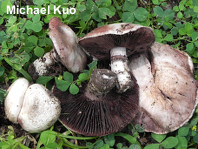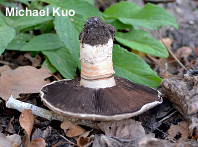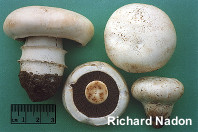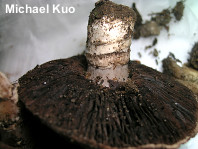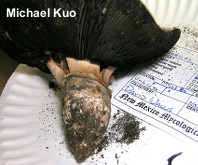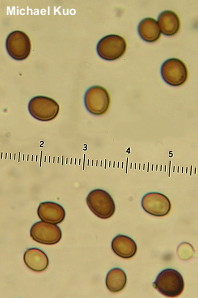| Major Groups > Gilled Mushrooms > Dark-Spored > Agaricus > Agaricus bitorquis |

|
Agaricus bitorquis [ Basidiomycota > Agaricales > Agaricaceae > Agaricus . . . ] by Michael Kuo Agaricus bitorquis can be found throughout the northern hemisphere, usually in urban areas, in hard-packed soil; it is often found next to roads, on well-worn paths in parks, in ditches—and even pushing up through asphalt and concrete. Identifying physical features include the tough, squat stem with a "peronate" veil (a sheathing, rather than skirt-like, ring) that often forms double bands; the lack of any prominent bruising or staining reactions; and the lack of a distinctive odor. Agaricus bernardi is similar in appearance, but appears in different habitats, readily stains red, and smells briny.
Description: Ecology: Saprobic; growing alone, scattered, or gregariously in hard-packed soil—along roadsides, near curbs, in parks, in ditches, and so on (also reported, not infrequently, to arise from cracks in concrete); summer and fall, or winter and spring in warm climates; widely distributed in North America. The illustrated and described collections are from Illinois, Colorado, New Mexico, Pennsylvania, and Québec. Cap: 4–11 cm; convex, becoming broadly convex or nearly flat; dry; bald; sometimes becoming cracked, roughened, or subscaly; whitish; rarely discoloring pinkish in old age or in wet weather; the margin not lined, and not yellowing when rubbed repeatedly. Gills: Free from the stem; close or crowded; short-gills frequent; pinkish at first, becoming brown and then dark chocolate brown in maturity; covered with a white partial veil when in the button stage. Stem: 2–6 cm long; 1–3 cm thick; squat and very tough; equal or tapering to base; bald or finely roughened; with a tightly sheathing white ring that often flares outward on its upper edge—and sometimes with a double sheathing ring, or in some collections an almost volva-like sheath; whitish to brownish; not bruising. Flesh: White; firm; unchanging when sliced, or rarely turning slightly reddish (especially in wet weather). Odor: Not distinctive. Chemical Reactions: KOH negative on cap surface. Spore Print: Dark brown. Microscopic Features: Spores: 5.5–7 x 4–5 µm; broadly ellipsoid; smooth; thick-walled; brown in KOH, with a pale, contrasting apiculus; brown in Melzer's. Basidia mostly 2-sterigmate. Cheilocystidia inconspicuous; basidiole-like. Pleurocystidia not found. Pileipellis a poorly defined cutis; elements 2.5–7.5 µm wide, smooth, hyaline to yellowish or brownish in KOH. REFERENCES: (Quélet, 1884) Saccardo, 1887. (Smith, Smith & Weber, 1979; Arora, 1986; Kerrigan, 1986; Phillips, 1991/2005; Lincoff, 1992; Barron, 1999; Mitchell & Bresinsky, 1999; Nauta, 2001; Robison et al., 2001; Challen, Kerrigan & Callac, 2003; Didukh et al., 2005; McNeil, 2006; Miller & Miller, 2006; Geml et al., 2008; Knudsen, Lange & Knutsson, 2008; Kerrigan et al., 2008; Desjardin, Wood & Stevens, 2015; Kerrigan, 2016; Siegel & Schwarz, 2016.) Herb. Kuo 06261102, 07241303, 07201402. Herb. DBG RMNP 2008-265. This site contains no information about the edibility or toxicity of mushrooms. |
© MushroomExpert.Com |
|
Cite this page as: Kuo, M. (2017, December). Agaricus bitorquis. Retrieved from the MushroomExpert.Com Web site: http://www.mushroomexpert.com/agaricus_bitorquis.html |
